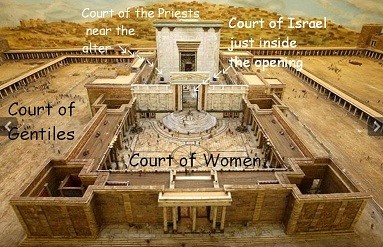
The “Second Temple” of Judaism – the magnificent center of worship that stood in Jerusalem during the time of Jesus – represented an architecture of exclusion.
A few people were in. Everyone else was out.
Around the perimeter of the Temple was the Court of the Gentiles. A few decades ago archeologists excavating the site found an ancient sign that promised death to any non-Jew who tried to enter the interior Temple courts. They would “only have themselves to blame” for that fate.
Females could access the main portal into the Court of Women. But a grate prevented them from going any farther.
Jewish men could walk beyond the grate into the Court of Israel. But only the Levites – those who could demonstrate an unbroken genealogical link to the Old Testament patriarch Levi – could occupy the Court of the Priests.
Remember the TV sitcom Get Smart, where every episode begins with Maxwell Smart walking through a series of opening and closing doors in order to approach his intelligence agency’s inner sanctum? Only a very few Jewish men – the Levites who were selected by lot for a brief period of priestly service – could cross the threshold into the Temple itself.
They would walk up 12 steps into the Temple vestibule, and then into the Holy Place.
But there was one place even more exclusive. In the heart of the Temple’s interior was the Holy of Holies.
Just one man – the current Jewish high priest – could go beyond the thick curtain that hung from the Temple’s ceiling between the Holy Place and the Holy of Holies. And he could do that only one day each year, the Day of Atonement, when he would offer sacrifices for his own sins and the sins of the entire Jewish nation.
The Temple was thus a kind of architectural Purity Filter in which fewer and fewer people were granted access to the presence of God. The signs and the gates were explicit: Stay back. Keep out. This means you.
In fact, way more than 99% of humanity – every non-Jew – was specifically excluded from setting foot inside the Temple complex. In the minds of the religious Establishment at the time of Jesus, Gentiles could never really get close to God.
Ever.
But all that began to change during the last week of Jesus’ life.
Jesus openly declared that the Temple and its corrupt spiritual vanguard would disappear within a generation – something that happened in A.D. 70 when the Romans overran the city.
He then reminded the crowds that the Temple was always intended to be a “house of prayer for all nations” (Mark 11:17) – not an exclusive club, but a representation of God’s open arms.
The most dramatic event, however, happened at the moment of Jesus’ death on the cross. Matthew 27:51 reports that the curtain separating the Holy Place from the Holy of Holies was “torn in two, from top to bottom.”
In Bible times, if a Jewish father should receive the heart-shattering news that his oldest son had died, he would tear his clothes from top to bottom. It was the ultimate sign of a father’s grief.
The anguish of God the Father was thus on display at the crucifixion of his Son.
But God’s greatest loss turned out to be our greatest gain.
For the barrier is down. The way is now clear.
You and I have access to the true “Holy of Holies” – the privilege of walking with God – every hour of every day.
By God’s grace, don’t miss that opportunity today.
